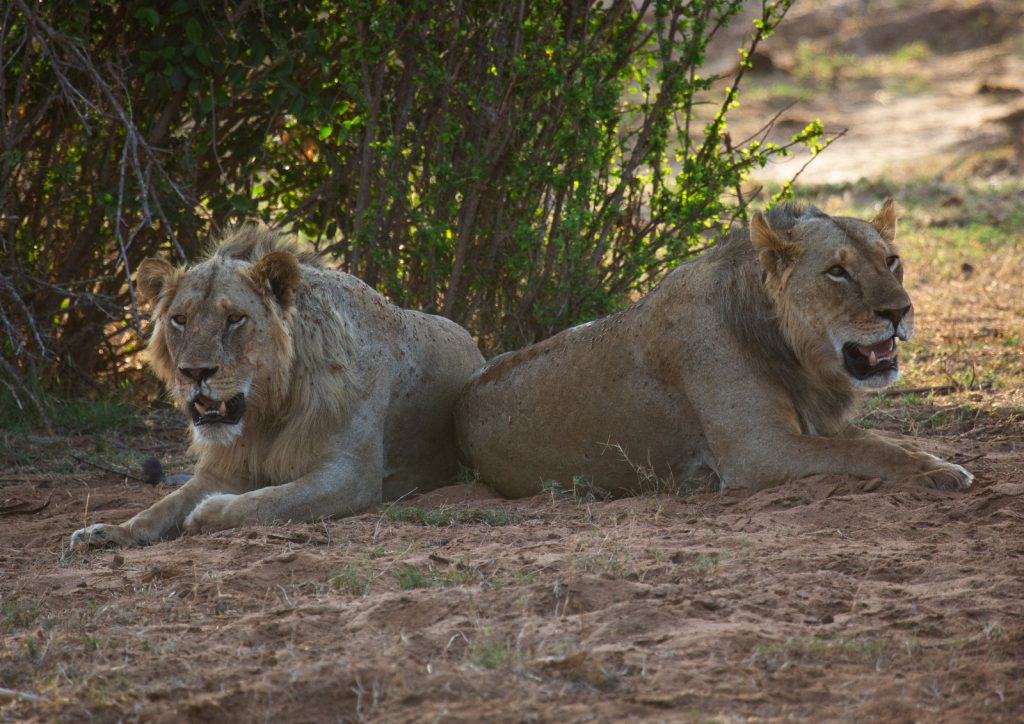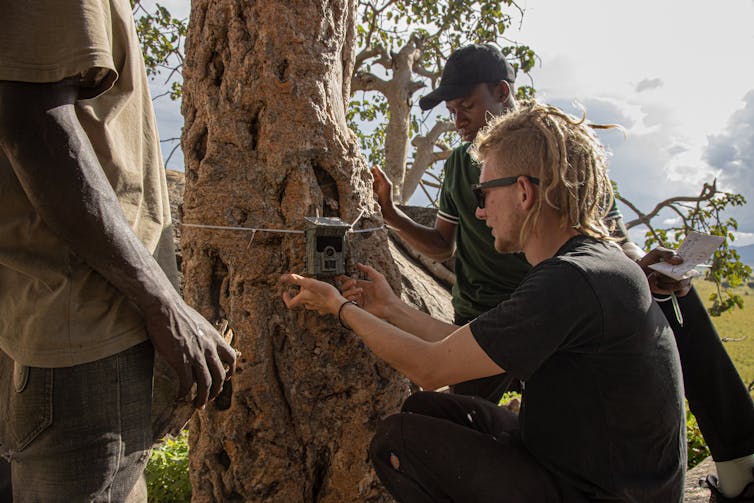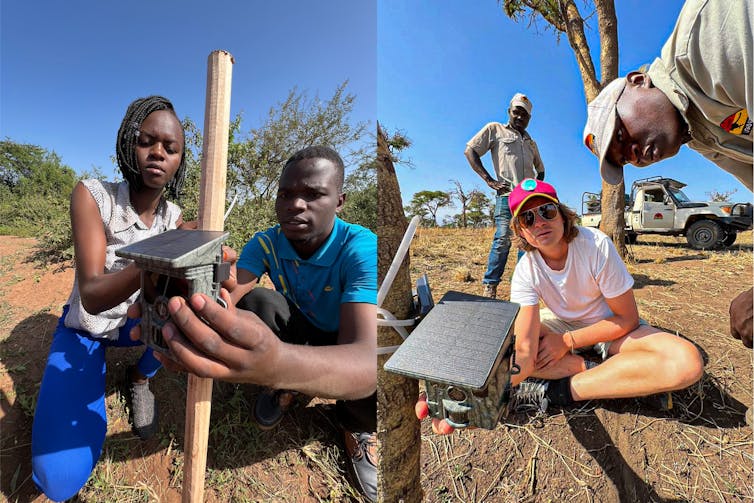
(File picture by Eric Lafforgue/Artwork in All of Us/Corbis by way of Getty Photos)
For almost 15 years nearly no info was accessible on the inhabitants standing of Uganda’s massive carnivores, together with these in its largest nationwide park, Murchison Falls.
These species characterize a crucial a part of Uganda’s rising tourism financial system. The nation is residence to the famed tree-climbing lions, that are a lot wanted for this distinctive behaviour. Collectively, lions and leopards generate tens of hundreds of {dollars} yearly from safari viewing and allied actions.
Maintaining a tally of the proverbial prize couldn’t be extra crucial for the nation. When wildlife isn’t monitored rigorously, populations can disappear inside only a few years, as tigers did in India’s Sariska tiger reserve.
However many individuals working in conservation discourage monitoring. They argue {that a} “bean counter” strategy to conservation overlooks the funds and actions that save animals. Others merely say that it’s a arduous factor to do at scale and notably for animals which might be naturally shy, have huge residence ranges (typically over a number of international locations), and happen in very low numbers.
Even in a relatively small African nation – Uganda ranks thirty second in dimension out of 54 international locations – how does one cowl sufficient floor to see how populations of carnivores are faring? This has been the problem of our work in Uganda for almost a decade now, monitoring African lions, leopards and noticed hyenas.

Our two latest research in Murchison Falls and six protected areas throughout the nation sought to deal with the issue by drawing on a variety of native and worldwide consultants who dwell and work in Uganda.
Working with the Ugandan authorities’s Uganda Wildlife Authority analysis and monitoring staff, we got down to establish and produce collectively impartial scientists, authorities rangers, college college students, lodge homeowners and conservation managers within the nation’s main savanna parks.
We hoped to cowl extra floor with folks and organisations that wouldn’t historically work collectively. Doing so uncovered many of those people for the primary time to the science and subject expertise wanted to construct strong, long run monitoring programmes for threatened wildlife.
The result’s the biggest, most complete rely of African lions, leopards and noticed hyenas.
We discovered noticed hyenas to be doing much better than we anticipated. However lions are in worrying decline, indicating the place conservation efforts should be centered. Past that, our rely proved the worth of collaborating in terms of producing information that might assist save animals.
Our distinctive strategy
Impressed by Kenya’s first nationwide, science-based survey of lions and different carnivores in key reserves, the primary vital step of this examine was to safe the collaboration of the Uganda Wildlife Authority’s workplace of analysis and monitoring.
Collectively, we recognized the crucial conservation stakeholders in and round six protected areas. These are Pian Upe Wildlife Reserve, Kidepo Valley, Toro Semliki, Lake Mburo, Queen Elizabeth and Murchison Falls. Leopards and hyenas happen in another parks (similar to Mount Elgon and Rwenzori Nationwide Park) however useful resource constraints prevented us from surveying these websites.
We had no predisposed notions of who might or would take part in our carnivore surveys, solely that we wished folks dwelling closest to those species within the room.
We shortlisted lodge homeowners, authorities rangers, impartial scientists, college college students from Kampala, NGO workers and even trophy hunters. All got here collectively for just a few days to study the way to discover carnivores in every panorama, construct detection histories and analyse information.
We delivered 5 technical workshops displaying individuals the way to seek for African lions within the landscapes along with mapping precisely the place they drove.

We additionally taught individuals:
- the way to establish lions by their whisker spots in high-definition images – these are the small spots the place a cat’s whiskers originate on their cheeks
- the way to decide id in digital camera lure photos of leopard and noticed hyena physique flanks
- put up information assortment evaluation methods
- a way to estimate inhabitants densities and abundance.
Greater than 100 Ugandan and worldwide collaborators joined within the “all fingers on deck” survey, driving over 26,000km and recording 7,516 digital camera lure nights from 232 areas spanning a 12 months from January 2022 to January 2023.
Our scientific strategy centered on the way to obtain the very best counts of carnivores. Within the course of we recognized a few of the greatest shortcomings of earlier surveys. These included double counting particular person animals and failing to include detection likelihood. Even worse was merely including all particular person sighted animals and never producing any local-level estimates.
The outcomes
As anticipated, our outcomes painted a grim image in some areas, however marked hope for others.
- Within the majestic Murchison Falls nationwide park, by which the River Nile runs east-west, we estimated that roughly 240 lions nonetheless remained throughout some 3,200km² of sampled space. That is the best quantity in Uganda and a minimum of 5 to 10 occasions increased than within the Kidepo and Queen Elizabeth parks.
- In Queen Elizabeth nationwide park, residence to the tree-climbing lions, we discovered a marked decline of over 40% (simply 39 people left in 2,400km²) since our final survey in 2018.
- Within the nation’s north, Kidepo Valley, the very best estimate is simply 12 particular person lions throughout 1,430km², in stark distinction with the earlier estimate of 132 lions applied almost 15 years in the past.
In distinction, leopards appeared to proceed to happen at excessive densities in choose areas, with Lake Mburo and Murchison Falls exhibiting robust populations. Pian Upe and Queen Elizabeth’s Ishasha sector recorded the bottom densities.
Noticed hyenas have confirmed way more resilient. They happen at densities starting from 6.15 to 45.31 people/100km² throughout surveyed websites. In Queen Elizabeth, their numbers could possibly be rising as lion populations decline, doubtless as a consequence of diminished competitors and ongoing poaching stress concentrating on lions.
These findings underscore the pressing want for focused conservation interventions, notably for lions in Uganda’s struggling populations.
Worth past numbers
Our strategy shared the load of knowledge assortment, and gave folks a chance and expertise to interact in wildlife science.
For a lot of rising conservationists within the nation, this was their first probability to be authors on a scientific paper (an more and more vital part of postgraduate diploma purposes).
Even when most of the folks we labored with disagree on the way to save massive carnivores in Uganda, they might a minimum of agree on what number of there are as that they had a hand in amassing the information and scrutinising it.
Since now we have embraced a completely science-based strategy, we recognise that our surveys too ought to enhance over time.
Aggrey Rwetsiba, senior supervisor, analysis and monitoring at Uganda Wildlife Authority, contributed to the analysis on which this text relies.
This text first appeared in The Dialog.